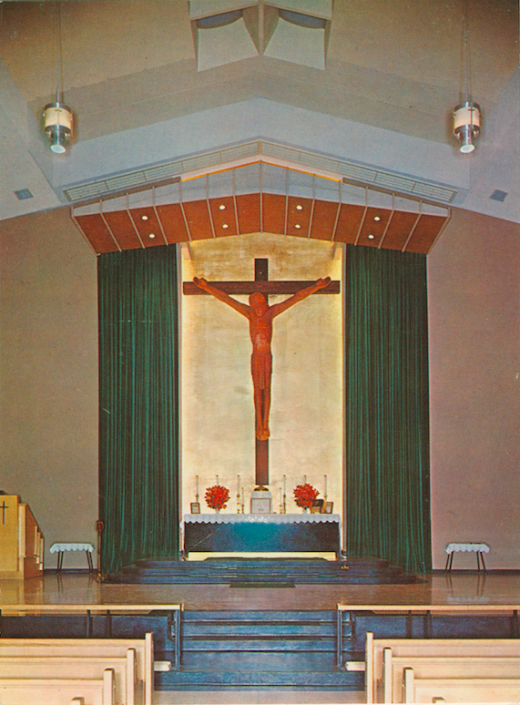Art as Prayer, Faith as Art
Archbishop Thomas Wenski

Detail of Christmas card from project architect Thomas Madden to Ivan and Olga Mestrovic showing the crucifix in Corpus Christi, 1960. University of Notre Dame Archives.
In Florida, however—where almost everything was built the day before yesterday, and quickly— most houses of worship lack aesthetic appeal and are blandly utilitarian in design. There are, unfortunately, very few churches in the region that offer worshippers and visitors the opportunity to be moved by the beautiful. Corpus Christi Parish, under the leadership of Father Jose Luis Menendez, is well along in the process of filling that void. Located in the Allapattah neighborhood, just blocks west of the famous Wynwood Walls, the ten-acre plot is centered on a plaza that will soon welcome visitors to one of the largest collections of Spanish-Colonial Baroque art in the United States. Paintings, prints, sculptures, and architectural elements will fill the yet-unfinished Chapel-Museum, itself modeled after a Spanish mission church of colonial Peru. The religious art inside is nothing short of inspirational.
Yet for whatever attention this new project may receive, let it not overshadow an equally inspirational work that has been hidden in plain sight for nearly sixty years: the monumental wooden crucifix adorning the sanctuary of the main church. Carved in 1959 from a single mahogany log by renowned sculptor Ivan Mestrovic, the sculpture is one of eight works that the Croatian émigré artist created for the church in South Florida, each testifying to an act of self-sacrifice and salvation. In addition to the eighteen-foot crucifix in the Corpus Christi Parish church, his over-life-sized Pietá on the grounds of the Archdiocese of Miami’s Pastoral Center can be seen by passersby on Biscayne Boulevard if they took the time to notice. This bronze depiction of the mother mourning her son is located in a small garden, where it is surrounded by six granite relief portraits commemorating bishops who suffered persecution by communist authorities during the 1950s. Mestrovic himself came to the United States after similarly enduring harassment by the Yugoslav government following the Second World War. Many of his most notable works were repatriated to his native Croatia; absent a visit to Zagreb, Miami offers perhaps the most direct window into the personal concerns and creative achievements of an artist who has been hailed as the greatest religious sculptor since the Renaissance.
The area surrounding Corpus Christi is quickly being “discovered” by developers, investors, and other interested parties as gentrification migrates west of I-95. Between visiting art exhibits and sampling craft beers, those seeking cultural experiences in more established environs might find that a detour to the other side of the interstate will be richly rewarded—perhaps not only in this life, but also in the next.
Archbishop Thomas G. Wenski was ordained a priest of the Archdiocese of Miami in 1976, and since then has served in several leadership roles within the Church. In 2010, Pope Benedict XVI appointed him the fourth Archbishop of Miami and Metropolitan of the Province of Miami. Archbishop Wenski speaks fluent English, Haitian Creole, and Spanish, and preaches and celebrates Mass regularly in all three languages.










